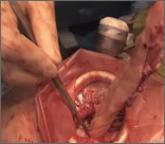The actions taken by the US Food and Drug Administration (FDA) and medical device companies to limit use of power morcellation have effectively led to a halt in the use of minimally invasive surgery for removal of large uterine fibroids. This would seem to leave open laparotomy as the only viable choice for the conservative removal of these benign tumors in women who choose to retain their uterus for personal, cultural, or childbearing reasons. Or does it?
Any open myomectomy of an intramural or subserosal myoma involves an incision into the uterine serosa and muscularis, thus exposing the surface of the tumor to the peritoneal environment. The mass is then grasped with penetrating instruments and manipulated free of its myometrial attachments with other instruments such as forceps, scissors, and electrocautery devices. Suction instruments are freely employed over the operative field. The gloved digits of the surgeon are frequently used to bluntly dissect the tumor from the surrounding myometrial bed.
Because of the desire to maximize future fertility potential by minimizing adhesions, frequent irrigation is considered by most reproductive surgeons to be a necessary part of good surgical technique. Irrigation hydrates the tissues and carries away blood, but it can be counted on to disperse countless cells from the exposed surface of the tumor. After resection, the tumor is removed from the operative field and handed off, usually to the gloved hand of an assistant who will be handling all of the tools that are used from that point forward. If an abscess is a “dirty case” from the standpoint of the spread of infection, then any myomectomy is a potentially “dirty case” from the standpoint of the spread of neoplasia. Given the fundamental nature of this procedure, there seems to be no way to do a “clean” myomectomy.
Since any form of myomectomy involves at least as much manipulation of the tumor mass as morcellation, it should be at least as likely as morcellation to spread aberrant cells. An inadvertent exposure of the unprotected surface of a leiomyosarcoma at the time of a traditional open myomectomy is not different in any essential way from the exposure of the surface of the same tumor at the time of a myomectomy followed by any type of morcellation.
It is logical then that if morcellation can be proscribed by regulation and litigation, myomectomy itself will be proscribed on the exact same lines of reasoning.
Despite the widespread use of either abdominal or minimally invasive myomectomy over the last 75 years, disseminated uterine leiomyosarcoma is now and always has been a rare disease. This fact has always been accounted for in our risk assessments of leiomyoma surgeries. In addition, there is no scientific evidence that power morcellation, nonpowered morcellation, or abdominal myomectomy without morcellation has ever been causative in the spread of even one patient’s leiomyosarcoma. Leiomyosarcoma is by definition capable of disseminating by itself.
No medical authority would recommend total hysterectomy for every patient with any myoma, based on the possibility that any individual patient might be harboring a uterine cancer that can spread. This is, however, the exact evolutionary endpoint of the reasoning of the FDA and our legal system. The device companies are to be the deep pockets of the morcellation lawsuits and physicians will be the deep pockets of future myomectomy lawsuits. Gynecologists have always considered risk/reward factors in decisions regarding myomectomy and morcellation. We have an obligation to defend the reproductive rights of our patients. Lawyers, regulators, and even the corporations that dominate the medical device market are motivated by other concerns.
The practice of modern medicine aggressively challenges clinical decision-making based solely on anecdotal evidence. It has done so for well over a century now. It is one of the few standards that still unites good doctors under the battered and tattered umbrella of our professionalism. Our challenge as modern physicians is to stand fast against our new regulatory masters (as well as their former and future law partners) with their grave misunderstandings of the very character of gynecologic decision-making.
Michael C. Doody, MD, PhD
Knoxville, Tennessee
I tried this technique as outlined in the video—totally awesome! It worked really well! Thanks to the surgeons who came up with it!
Ravindhra Mamilla, MD
Thief River Falls, Minnesota




